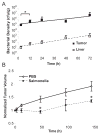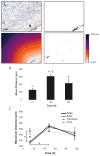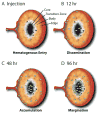In tumors Salmonella migrate away from vasculature toward the transition zone and induce apoptosis
- PMID: 21436868
- PMCID: PMC3117926
- DOI: 10.1038/cgt.2011.10
In tumors Salmonella migrate away from vasculature toward the transition zone and induce apoptosis
Abstract
Motile bacteria can overcome diffusion resistances that substantially reduce the efficacy of standard cancer therapies. Many reports have also recently described the ability of Salmonella to deliver therapeutic molecules to tumors. Despite this potential, little is known about the spatiotemporal dynamics of bacterial accumulation in solid tumors. Ultimately this timing will affect how these microbes are used therapeutically. To determine how bacteria localize, we intravenously injected Salmonella typhimurium into BALB/c mice with 4T1 mammary carcinoma and measured the average bacterial content as a function of time. Immunohistochemistry was used to measure the extent of apoptosis, the average distance of bacteria from tumor vasculature and the location of bacteria in four different regions: the core, transition, body and edge. Bacteria accumulation was also measured in pulmonary and hepatic metastases. The doubling time of bacterial colonies in tumors was measured to be 16.8 h, and colonization was determined to delay tumor growth by 48 h. From 12 and 48 h after injection, the average distance between bacterial colonies and functional vasculature significantly increased from 130 to 310 μm. After 48 h, bacteria migrated away from the tumor edge toward the central core and induced apoptosis. After 96 h, bacteria began to marginate to the tumor transition zone. All observed metastases contained Salmonella and the extent of bacterial colocalization with metastatic tissue was 44% compared with 0.5% with normal liver parenchyma. These results demonstrate that Salmonella can penetrate tumor tissue and can selectively target metastases, two critical characteristics of a targeted cancer therapeutic.
Figures






References
-
- Sporn MB. The war on cancer. Lancet. 1996;347(9012):1377–81. - PubMed
-
- Cairns R, Papandreou I, Denko N. Overcoming physiologic barriers to cancer treatment by molecularly targeting the tumor microenvironment. Mol Cancer Res. 2006;4(2):61–70. - PubMed
-
- Minchinton AI, Tannock IF. Drug penetration in solid tumours. Nat Rev Cancer. 2006;6(8):583–92. - PubMed
-
- Albini A, Sporn MB. The tumour microenvironment as a target for chemoprevention. Nat Rev Cancer. 2007;7(2):139–47. - PubMed
Publication types
MeSH terms
Grants and funding
LinkOut - more resources
Full Text Sources
Other Literature Sources

